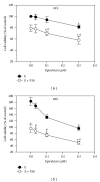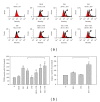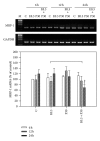Progesterone increases apoptosis and inversely decreases autophagy in human hepatoma HA22T/VGH cells treated with epirubicin
- PMID: 24971383
- PMCID: PMC4055367
- DOI: 10.1155/2014/567148
Progesterone increases apoptosis and inversely decreases autophagy in human hepatoma HA22T/VGH cells treated with epirubicin
Abstract
Hepatocellular carcinoma (HCC) is the leading cause of cancer-related deaths worldwide. Epirubicin can induce intracellular reactive oxygen species and is widely used to treat unresectable HCC. Progesterone has been found to inhibit the proliferation of hepatoma cells. This study was designed to test the combined effects of epirubicin and progesterone on human hepatoma cell line, HA22T/VGH. These cells were treated with different concentrations of epirubicin with or without the coaddition of 30 μM progesterone and then analyzed for apoptosis, autophagy, and expressions of apoptotic-related proteins and multidrug-resistant gene. Epirubicin treatment dose-dependently inhibited the growth of HA22T/VGH cells. Addition of 30 μM progesterone, which was inactive alone, augmented the effect of epirubicin on the inhibition of growth of HA22T/VGH cells. Cotreatment with progesterone enhanced epirubicin-induced apoptosis, as evidenced by greater increase in caspase-3 activity and in the ratio of the apoptosis-regulating protein, Bax/Bcl-X(L). The combination also caused a decrease in autophagy and in the expression of multidrug resistance-related protein 1 mRNA compared to epirubicin alone. This study shows the epirubicin/progesterone combination was more effective in increasing apoptosis and inversely decreasing autophagy on HA22T/VGH cells treated with epirubicin alone, suggesting that this combination can potentially be used to treat HCC.
Figures






Similar articles
-
Progesterone augments epirubicin-induced apoptosis in HA22T/VGH cells by increasing oxidative stress and upregulating Fas/FasL.J Surg Res. 2014 May 15;188(2):432-41. doi: 10.1016/j.jss.2014.01.063. Epub 2014 Feb 5. J Surg Res. 2014. PMID: 24594218
-
Arecoline induces HA22T/VGH hepatoma cells to undergo anoikis - involvement of STAT3 and RhoA activation.Mol Cancer. 2010 May 28;9:126. doi: 10.1186/1476-4598-9-126. Mol Cancer. 2010. PMID: 20507639 Free PMC article.
-
Antitumor effects of the novel NF-kappaB inhibitor dehydroxymethyl-epoxyquinomicin on human hepatic cancer cells: analysis of synergy with cisplatin and of possible correlation with inhibition of pro-survival genes and IL-6 production.Int J Oncol. 2006 Apr;28(4):923-30. Int J Oncol. 2006. PMID: 16525642
-
Formononetin potentiates epirubicin-induced apoptosis via ROS production in HeLa cells in vitro.Chem Biol Interact. 2013 Oct 5;205(3):188-97. doi: 10.1016/j.cbi.2013.07.003. Epub 2013 Jul 16. Chem Biol Interact. 2013. PMID: 23867903
-
Increase of Bax/ Bcl-XL ratio and arrest of cell cycle by luteolin in immortalized human hepatoma cell line.Life Sci. 2005 Mar 4;76(16):1883-93. doi: 10.1016/j.lfs.2004.11.003. Epub 2005 Jan 20. Life Sci. 2005. PMID: 15698865
Cited by
-
Progesterone receptor membrane component 1 as a potential prognostic biomarker for hepatocellular carcinoma.World J Gastroenterol. 2018 Mar 14;24(10):1152-1166. doi: 10.3748/wjg.v24.i10.1152. World J Gastroenterol. 2018. PMID: 29563759 Free PMC article.
-
A 4-Phenoxyphenol Derivative Exerts Inhibitory Effects on Human Hepatocellular Carcinoma Cells through Regulating Autophagy and Apoptosis Accompanied by Downregulating α-Tubulin Expression.Molecules. 2017 May 21;22(5):854. doi: 10.3390/molecules22050854. Molecules. 2017. PMID: 28531143 Free PMC article.
-
A three-mRNA status risk score has greater predictive ability compared with a lncRNA-based risk score for predicting prognosis in patients with hepatocellular carcinoma.Oncol Lett. 2020 Oct;20(4):48. doi: 10.3892/ol.2020.11911. Epub 2020 Jul 24. Oncol Lett. 2020. PMID: 32788937 Free PMC article.
-
Autophagy and liver cancer.Turk J Gastroenterol. 2018 May;29(3):270-282. doi: 10.5152/tjg.2018.150318. Turk J Gastroenterol. 2018. PMID: 29755011 Free PMC article. Review.
-
The transgenic expression of the β-subunit of human chorionic gonadotropin influences the growth of implanted tumor cells.Oncotarget. 2018 Oct 5;9(78):34670-34680. doi: 10.18632/oncotarget.26158. eCollection 2018 Oct 5. Oncotarget. 2018. PMID: 30410667 Free PMC article.
References
-
- El-Serag HB. Hepatocellular carcinoma. New England Journal of Medicine. 2011;365(12):1118–1127. - PubMed
-
- Ferlay J, Shin HR, Bray F, Forman D, Mathers C, Parkin DM. Estimates of worldwide burden of cancer in 2008: GLOBOCAN 2008. International Journal of Cancer. 2010;127(12):2893–2917. - PubMed
-
- Chang WT, Kao WY, Chau GY, et al. Hepatic resection can provide long-term survival of patients with non-early-stage hepatocellular carcinoma: extending the indication for resection? Surgery. 2012;152(5):809–820. - PubMed
Publication types
MeSH terms
Substances
LinkOut - more resources
Full Text Sources
Other Literature Sources
Medical
Research Materials

